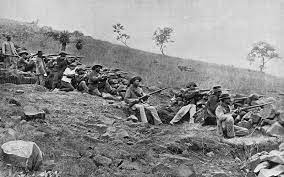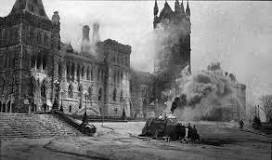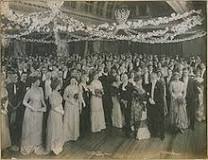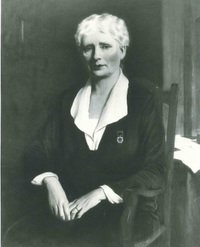IODE by BARNEY MOORHOUSE For Reproduction Rights call Access 1-800-893-5777
PART 1
The Imperial Order Daughters of the Empire
I first learned of the IODE during Miss Coverdale’s, a.k.a. Miss Covergirl’s, grade 13 history class in 1964. In addition to the regular material we learned about The Depression, which, like the war, was seldom mentioned at home (I suppose because of the sad memories), binder twine (“You don’t know what binder twine is?”) and other items pertaining to history that she taught to make the subject live. It wasn’t until I was at an elk committee wrap up picnic in 2008 that I learned the IODE is still alive and well in Canada.
Marie Locke of Campbellford is part of the National executive and when I expressed interest she promised to gather some materials to further my education. And so I thought that I would pass on some of the gleanings.
One hundred and eight years ago Margaret Polson Murray (see featured image at top of the article) sought to form an organization to benefit others: 1. to promote education; 2. to care for widows, orphans and dependants of Canadian and Empire (Commonwealth) soldiers, sailors and airmen; 3. to help those in poverty or distress irrespective of race, colour, creed or sex and 4. to give donations for charitable purposes.
Margaret Polson was born June 1, 1844 in Paisley, Scotland. At 21 she married John Clark Murray, Professor of Philosophy at Queen’s University and later McGill. She was one of seven women who founded the Montreal YWCA in 1874. In 1899, when the South African war broke out, exposure to the range of emotions inspired her to found the IODE.
The IODE has chapters in all provinces and the Yukon. Two new chapters organized in 2007. As of 2007, there were approximately 5000 members. Educational support has included the Snack Pack program in Labrador, Adopt-A-Class programs, bursaries (which included recipient Adrienne Clarkson, former Governor General of Canada when she was a university student) and scholarships. A new project, as part of the IODE’s Read for Life initiative in 2006, recognized that boys aged 7-14 scored lower than girls on standardized tests in Language Arts and were more likely to be placed in special education programs, less likely to go to university and more likely to drop out of school. As a result boys became the special focus of IODE chapters. In 2007, educational support totaled $709,380. Of interest, the proposed budget for 2008 noted a balance of $6.00. This organization doesn’t sit on its funds. Afghanistan has stimulated an increase in support for members of the Canadian Forces. As well, toys have been sent to soldiers stationed in Afghanistan for distribution to local village children. Closer to home chapter members have volunteered to the tune of 721,400 hours at Citizenship Courts, knitted afghans, mittens and sweaters for distribution to women’s shelters, seniors’ homes and hospitals; served food at youth shelters, and raised funds for “Grannies helping Grannies” in Africa. Chapters supported citizenship projects with $54,392.
Down Memory Lane Decade by Decade
1900 – 1909
IODE founded, first chapter in Fredericton, N.B. on Jan. 15, 1900, the Federation of the Daughters of the Empire and their motto, “For Queen and Country.” A red oak planted on the Legislative grounds May 24, 1900 survives as one of “The Great Trees of New Brunswick”. In 1901 head office moved to Toronto and the federation was incorporated as the Imperial Order Daughters of the Empire. The IODE supplied comforts for Empire forces in the Boer War and a monument in Bloemfontein, South Africa honouring 90 Canadian soldiers who gave their lives.

Canada’s population was 5,371,315 distributed through 7 provinces. Alberta and Saskatchewan joined Confederation in this decade. Reginald Fessenden transmitted the world’s first radio message, kidney transplants were performed on cats and dogs at a medical convention, a Toronto pharmacist John A. McLaughlin invented Canada Dry Ginger Ale in 1907 and the University of Toronto won the first Grey Cup defeating Parkdale Canoe Club 26-6. The first airplane flight took off at Baddeck, Nova Scotia, Eatons held its first Santa Claus Parade and Imperial Oil opened the first gas station in Vancouver where gasoline sold for 40 cents a gallon. (The station apparently purchased it for 20 cents a gallon.)
1910-1919
Concerned about Tuberculosis the IODE provided beds in existing sanatoria and opened the first Preventorium in North America in Toronto for children who had been exposed to but had not yet contracted the disease. The first tag day in Canada was IODE Rose Day, 1915. The IODE supported WW1 troops and victims and orphans of the Halifax explosion when a French munitions ship blew up killing 16,000, injuring 9000. Thanksgiving dinner for soldiers on Vancouver Island featured 1575 apple and mince tarts at the cost of 3 cents each. In 1919, the War memorial Fund was established to provide bursaries for sons and daughters of those killed or permanently disabled and to establish a permanent memorial of postgraduate scholarships. As WW1 came to an end the Parliament Buildings in Ottawa burned, influenza killed 50,000 Canadians, the federal income tax was introduced as a “temporary wartime measure” and Daylight Saving Time began.

This decade witnessed the birth of the Royal Canadian Navy and the Calgary Stampede. Emily Murphy, of Edmonton, was appointed the first woman magistrate in the British Empire, airmail between Montreal/Toronto required 6 hours, and the Group of Seven made their mark.
1920-1929
Vancouver IODE arranged the first Armistice Day Service; IODE chapters helped establish/sponsor Girl Guide Companies across Canada until 1946; the IODE calendar (still on-going) was introduced in 1925 to support the National education program.
Legislation in 1920 made women eligible to sit in the House of Commons. In 1921, Agnes McPhail was elected. King George V declared red and white our official colours. The Royal Canadian Air Force and CN Rail were created; the Bluenose was launched in Nova Scotia and Joseph-Armand Bombardier invented the snowmobile. Sir Frederick Banting, Dr. Charles Best and Dr. J.J.R. McLeod received the Nobel Prize for the discovery of insulin. The Red ensign became our official flag, Canada and the Dominions were declared equals of Britain and Canadian women were legally declared persons. Our first Old Age Pension Act paid $20/month for those over 70. Silent film was replaced by the “talkies”, “Faster” Foster Hewitt started Hockey Night in Canada and Chatelaine went to press for the first time.

1930-1939 (The Depression Decade)
The IODE opened relief centres to provide clothing, food and medical care. Manitoba members offered sewing classes to those on welfare, Alberta IODE provided textbooks for grades 1-9 in outlying schools in need, IODE organized the first sale of Christmas seals in B.C., chapters contributed to the International Peace Garden, located on either side of the Manitoba-North Dakota border and B.C. IODE began helping victims of cancer.
Nationally, Cairine Wilson became Canada’s first woman senator, IODE member Mrs. George Black was the Yukon’s first female Member of Parliament, the Bank of Canada was born, as were the Canadian Wheat Board, CBC and National Film Board. North Bay’s Dionne quintuplets were also born, Pablum was widely used, and poor Maritime children had to eat lobster sandwiches for lunch. According to dieticians a family of five could eat for $7.65 a week. Canada declared war on Germany September 19, 1939.
I published this article in 2008.
